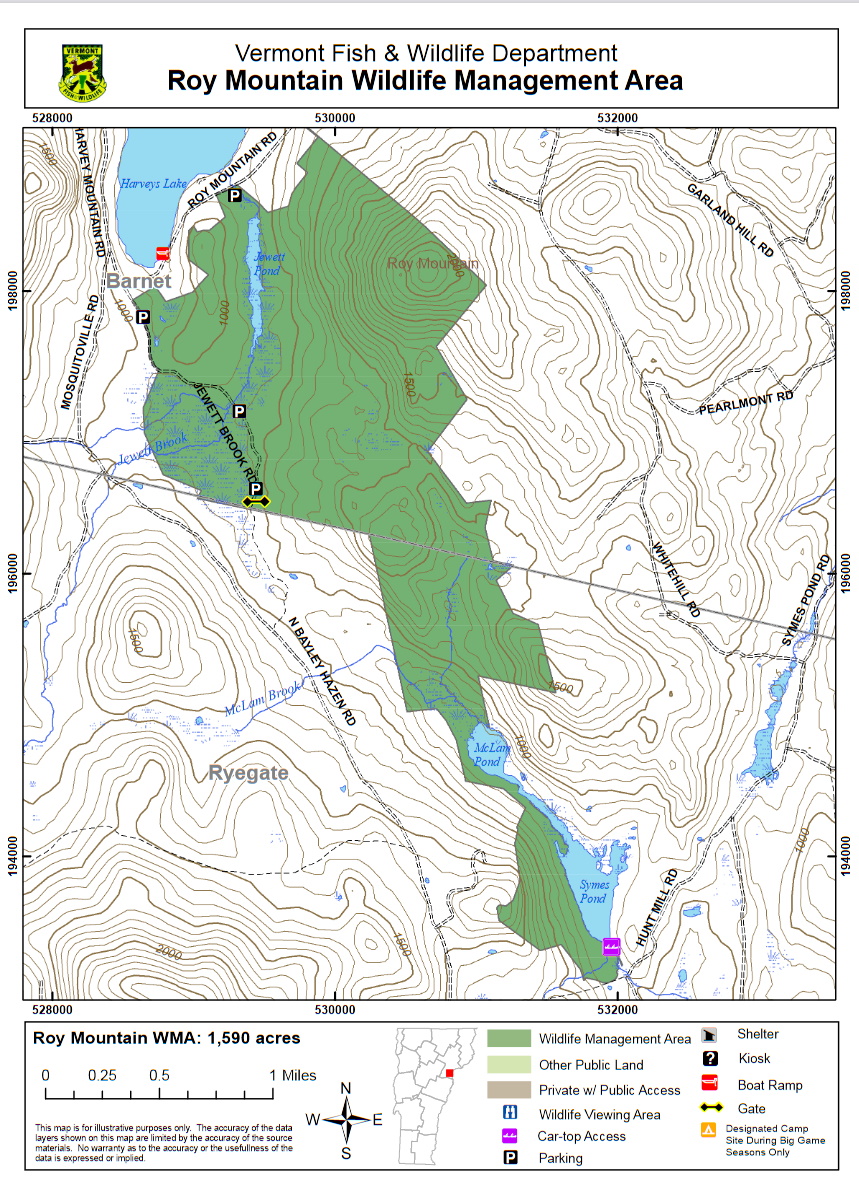Roy Mountain WMA
Birds of Interest
There are suitable nesting sites at the ponds and beaver flowages throughout Roy Mountain Wildlife Management Area for species such as black, wood, and mallard ducks, goldeneyes, and hooded mergansers. Several wood duck nesting boxes on Jewett Pond, which are maintained by the Department, are frequently utilized by wood ducks and hooded mergansers.
Favorable ruffed grouse habitat is limited to the vicinity of remnant agricultural fields where aspen and alder occur adjacent to herbaceous openings. The Department has “released” many apple trees clustered around the old homesteads. Cutting allows sunlight to reach the trees, which makes them more productive.
The great variety of forest and wetland habitats provides good bird-watching opportunities. Herons, snipe, and flycatchers are common in the wetlands. Neotropical migrants such as tanagers, thrushes, and many warbler species summer in the woodlands.
About this Location
Roy Mountain Wildlife Management Area (WMA) is a 1,590-acre parcel of land owned by the State of Vermont and managed by the Vermont Fish and Wildlife Department. The WMA is located within the towns of Barnet and Ryegate, and ranges from the top of Roy Mountain, west to Jewett Pond, and south to the shores of McLam Pond and Symes Ponds. Use the parking area on Roy Mountain Road for foot access. Symes Pond boat access is off Hunt Mill Road in Ryegate.
The lands on and around Roy Mountain were in the Roy family since the late 1800s. In 1924 they were sold to the Roy Lumber Company, at which time a dam and sawmill were built on Jewett Brook. The sawmill was in operation until about 1940. Today, the dam still holds back the waters of Jewett Pond.
The present-day landholdings of the WMA were acquired from 1966 through 1991 using several different funding mechanisms. The majority of the lands were purchased with U.S. Department of the Interior Land and Water Conservation Funds. Other funding sources included Vermont Fish & Wildlife Department and Pittman-Robertson funds. This program is funded by an 11% tax on rifles, shotguns, ammunition, and archery equipment. In 1991, a 148-acre parcel surrounding Jewett Pond was purchased through a cooperative effort of local, state, federal, and civic organizations. Among those who contributed include the town of Barnet, Friends of Jewett Pond, sportsmen, Vermont Housing and Conservation Board, and The Nature Conservancy. The Friends of Jewett Pond consisted of individuals, civic organizations, and concerned groups from around the area. Dollars came from the Dingell-Johnson Sportfish Restoration Fund and from Vermont’s Waterfowl Stamp Program. The Vermont Nature Conservancy contributed by making the initial purchase that took the property off the market long enough for sufficient funding to be raised by contributors.
Elevations on the WMA range from 900 feet to 2,091 feet atop Roy Mountain. The terrain varies from flat cedar swamps to steep pine-hemlock slopes along the mountain. The property is mostly forested. Major tree species are red and sugar maple, yellow birch, beech, hemlock, red oak, red pine, white pine, and white cedar. Several old fields with scattered apple trees, testaments of past farming, are located around the Dekoyer Place.
Wetland habitats throughout the WMA are diverse. The most notable of these is a cattail marsh, a large forested wetland along Jewett Brook, and shrub borders around the ponds scattered across the WMA. Two areas of ecological significance occur on the WMA. One is a 200-acre area on top of Roy Mountain that is dominated by red pine. This old-growth stand is one of the few natural red pine stands in Vermont. The other is a wetland containing the largest known population of sheathed sedge in the State.
Features
Restrooms on site
Wheelchair accessible trail
Entrance fee
Content from Roy Mountain Wildlife Management Area guide and map
Last updated December 3, 2023
